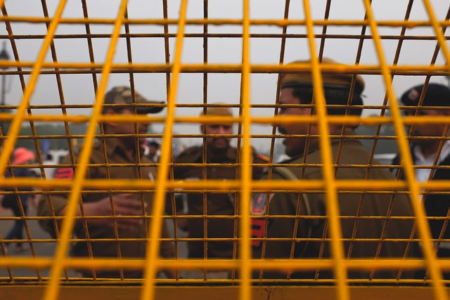Section 144 of the Code of Criminal Procedure (CrPC)
Context:
Section 144 of the Code of Criminal Procedure (CrPC) of 1973 has been imposed in Gurugram, owing to the rising number of Covid-19 cases.
Section 144 has often been used to clamp down on telecommunication services and order Internet shutdowns.
About Section 144 CrPC
It gives power to a District Magistrate, a sub- divisional Magistrate or any other Executive Magistrate on behalf of the State Government to issue an order to an individual or the general public in a particular place or area to “abstain from a certain act” or “to take certain order with respect to certain property in his possession or under his management”.
- This order can be passed against a particular individual or general public. The order can be passed even ex-parte.
- As held by the Supreme Court, mere apprehension of danger is not a sufficient ground to curb citizens’ rights by invoking Section 144 CrPC.
Difference between Section 144 and Curfew:
- Section 144 prohibits gathering of four or more people in the concerned area, while during curfew people are instructed to stay indoors for a particular period of time. The government puts a complete restriction on traffic as well.
- Markets, schools, colleges and offices remain closed under the curfew and only essential services are allowed to run on prior notice.
Implications of Section 144CrPC
- Section 144 restricts carrying any sort of weapon in that area where it has been imposed and people can be detained for violating it. The maximum punishment for such an act is three years.
- According to the order under this section, there shall be no movement of public and all educational institutions shall also remain closed.
- Further, there will be a complete bar on holding any kind of public meetings or rallies during the period of operation of this order.
- It is deemed a punishable offence to obstruct law enforcement agencies from disbanding an unlawful assembly.
- It also empowers the authorities to block internet access in the region.
- The ultimate purpose of Section 144 is to maintain peace and order in the areas where trouble could erupt to disrupt the regular life.
Duration of Section 144 order:
No order under Section 144 shall remain in force for more than two months but the state government can extent the validity for two months and maximum up to six months. It can be withdrawn at any point of time if situation becomes normal.
As per the Section, the order can be passed only “if such Magistrate considers”, that the direction is likely to prevent:
- obstruction, annoyance or injury to any person lawfully employed.
- danger to human life, health or safety.
- disturbance of the public tranquility, or a riot or affray.
The Supreme Court guidelines:
The orders under this provision will lead to the infringement of fundamental rights to freedom of speech and expression, assembly and movement guaranteed under Articles 19(1)(a),(b) and (c) of the Constitution. Hence, the orders under Section 144 have to meet the test of “reasonable restrictions” as per Article 19.
To ascertain whether a restriction on liberties guaranteed under Article 19 is reasonable or not, the Supreme Court has developed the “test of proportionality”.
In the Constitution Bench decision in Modern Dental College case (2016), the SC held that a law imposing restrictions will be treated as proportional if :
- It is meant to achieve a proper purpose, and
- If the measures taken to achieve such a purpose are rationally connected to the purpose, and
- If such measures are necessary.
Four-fold test to determine proportionality:
In Puttaswamy case (2017), the SC laid down a four-fold test to determine proportionality:
- A measure restricting a right must have a legitimate goal (legitimate goal stage).
- It must be a suitable means of furthering this goal (suitability or rationale connection stage).
- There must not be any less restrictive but equally effective alternative (necessity stage).
- The measure must not have a disproportionate impact on the right holder (balancing stage).
So, the legality of the orders passed under Section 144 CrPC will be tested on the basis of these principles of ‘reasonableness’ and ‘proportionality’.
Criticism of the Section:
- The criticism is that it is too broad and the words of the section are wide enough to give absolute power to a magistrate that may be exercised unjustifiably.
- The immediate remedy against such an order is a revision application to the magistrate himself.
- An aggrieved individual can approach the High Court by filing a writ petition if his fundamental rights are at stake. However, fears exist that before the High Court intervenes, the rights could already have been infringed.
Way forward
- Section 144 is a useful tool to help deal with emergencies. However, absence of any narrow tailoring of wide executive powers with specific objectives, coupled with very limited judicial oversight over the executive branch, makes it ripe for abuse and misuse.
- Before proceeding under this section, the Magistrate should hold an enquiry and record the urgency of the matter.
- There is a need to balance the granting of plenary powers by the legislature to deal with emergent situations, and the need to protect the personal liberty and other freedoms granted to the citizens under the fundamental rights of the Constitution.



